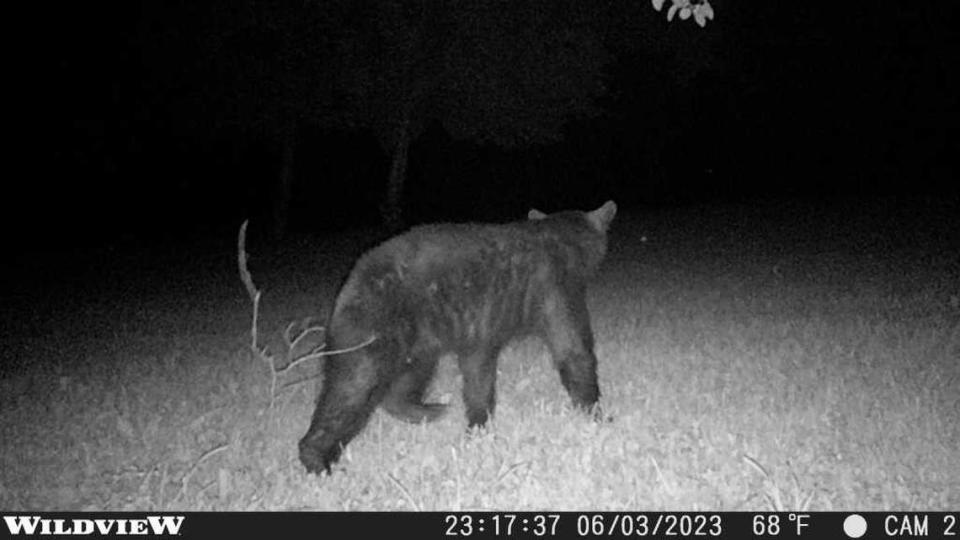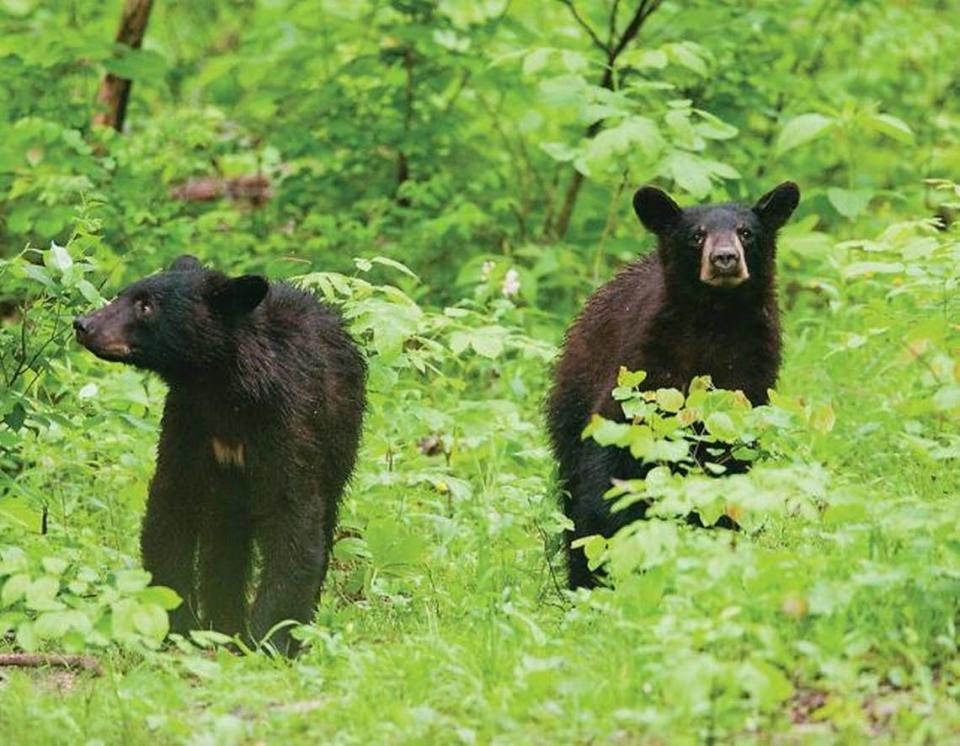Missouri’s bear population is growing. How many have been spotted near Kansas City?
When Walker Aldrige spotted a bear on a trail camera he had recently set up in Pleasant Hill, about 30 miles southeast of downtown Kansas City, he couldn’t believe his eyes.
“I was really surprised,” he said.
Aldrige sent photos of the black bear to his mom, dad and grandfather, who owns the land the bear sauntered through on camera.
“They were like, ‘Whoa, that’s cool,’” he said.
They suggested reporting the June 3 sighting to the Missouri Department of Conservation, which he did.
Nine bears have been confirmed so far this year in the Kansas City region, according to data from the department. The average the past nine years is about five sightings.
According to Nate Bowersock, the department’s black bear biologist, people used to observe bears in Missouri right at the Arkansas border. But now, sightings are fairly common in the southern half of the state and have spread north. Bears have also been seen in the Kansas City and St. Louis regions.
“At this point, there’s only a handful of counties north of the Missouri River that we haven’t confirmed a bear sighting,” Bowersock said. “So there’s some level of bear activity essentially almost statewide at this point, which is pretty cool.”
Bowersock said Missouri is one of the few areas in the country where black bears are “recolonizing.”
Missouri only has black bears, but they can display a wide range of coat colors, including black, brown, blonde or cinnamon red.
About 900 of the bears live in the state, which is experiencing an annual growth rate of 9%, a number Bowersock called “very healthy.”
The conservation department is conducting research to better understand Missouri’s bear population, including how many cubs are being born and surviving and their geographic distribution.
“There’s just a lot of open space for them to set up shop and do their own thing without having to compete with others,” Bowersock said.
Aldrige said he heard reports that the bear he saw had wandered to the Greenwood area, which is about five miles from the southeast edge of Kansas City’s city limits.
Now, when he goes out on his grandpa’s land, he looks for signs of a bear’s presence, like paw prints.
“I wish it would come back,” he said.

Hair snares and GPS collars
Bear reports increased in the early 2000s, prompting the state to initiate a number of studies.
In 2010, researchers started a hair snare study where they stretched barbed wire around three or more trees and placed smelly lure in the middle. Bears would amble into the enclosure, and their fur would catch in the wire. The hair samples were sent off for genetic testing and then population modeling.
By 2012, an estimated 350 bears were in Missouri, according to Bowersock.
The conservation department launched a new hair snare study two years ago, setting nearly 500 snares throughout the southern half of Missouri.
“We collected hair from a lot of different locations in the state,” Bowersock said. “We collected over 1000 hair samples.”
Researchers sent the samples to a genetics lab in Canada to identify individual bears. The conservation department is collaborating with Michigan State University to develop new population models, which will help guide management decisions, Bowersock said.
Conditions in Missouri have helped the bear population to thrive. That includes reforestation efforts and resource availability. Bears in Missouri primarily eat vegetation, including grasses, acorns and fruits like wild raspberries and persimmons. Occasionally, they will feed on roadkill or a deer fawn.
About 200 bears have also been outfitted with GPS collars to track their movements. At first, the conservation department was collaring any bear, but then they began to focus on females to learn more about them and their cubs. Future studies will focus on younger cubs and males to see how they are dispersing, Bowersock said.
Anecdotally, younger bears are moving north and east while adults have headed north and west, including into the Kansas City area. It’s unclear exactly why that pattern is playing out.
“There’s a lot of research, a lot of questions to be asked,” Bowersock said.
One other unknown is climate change. So far, Bowersock said, no evidence shows if the climate has had a positive or negative effect on Missouri’s bears.
“Right now, climate change isn’t really playing a factor in there, but with changes in weather cycles and weather patterns, maybe we could see something in the future, especially if it impacts the foods that they rely on,” he said.
“It is something we are keeping an eye on because that could be a factor down the line.”

Human-bear contact
There have not been any reports of attacks or injuries by bears in Missouri.
“Hopefully we keep that way,” Bowersock said.
The department is making efforts to educate the public through programs like Be Bear Aware. Research on bear populations and movements will also help officials decide where to deploy outreach and other resources aimed at raising awareness.
The biggest issue is food storage, Bowersock said.
“Human-bear conflicts happen because of unsecured food — bears getting into garbage or pet food left out or livestock such as chickens not being given the proper protection in bear country,” he said.
Bears are smart animals who will go after easy access to food, especially if it’s high in calories.
He advises those who run into a black bear to stay calm, slowly back away and make noise. Do not run.
Bears can be hunted in Missouri, but only state residents can apply for a permit through a lottery system. This year’s season runs from Oct. 16-25.
“Otherwise, bears cannot be shot unless there is concern for safety or if they’re attacking livestock,” Bowersock said.
Those instances have been few. Last year, there was one case where a landowner killed a bear that was attacking chickens.
The department has also conducted a “human dimension study.”
“We surveyed a bunch of Missouri residents and asked them a series of questions: What are your thoughts about bears? What do you know about bears?” Bowersock said. “Our big thing was just trying to set the tolerance level that Missourians have for bears. Overall, people have a pretty positive outlook about bears, but we would like to keep it that way.”

